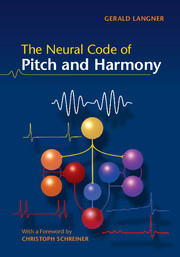Book contents
- Frontmatter
- Contents
- Preface
- Foreword
- 1 Historical aspects of harmony
- 2 Sound and periodicity
- 3 The discovery of the missing fundamental
- 4 The pitch puzzle
- 5 The auditory time constant
- 6 Pathways of hearing
- 7 Periodicity coding in the brainstem
- 8 Periodicity coding in the midbrain
- 9 Theories of periodicity coding
- 10 Periodotopy
- 11 The neural code of harmony
- 12 The oscillating brain
- References
- Index
4 - The pitch puzzle
Published online by Cambridge University Press: 05 May 2015
- Frontmatter
- Contents
- Preface
- Foreword
- 1 Historical aspects of harmony
- 2 Sound and periodicity
- 3 The discovery of the missing fundamental
- 4 The pitch puzzle
- 5 The auditory time constant
- 6 Pathways of hearing
- 7 Periodicity coding in the brainstem
- 8 Periodicity coding in the midbrain
- 9 Theories of periodicity coding
- 10 Periodotopy
- 11 The neural code of harmony
- 12 The oscillating brain
- References
- Index
Summary
The telephone theory
Although a broadband harmonic sound, for example a human vowel (see Figs. 2.8, 2.9), activates many sensory cells along the basilar membrane, it is typically perceived as an entirety and has just a single pitch. We neither hear the rapid amplitude fluctuations, due to its periodic envelope, nor realize that it is composed of a fundamental frequency and perhaps dozens of harmonics, which all have quite different pitches when heard separately. Helmholtz was able to single out individual harmonics of tones by means of his spherical resonators (see Fig. 3.5), but he could not explain the fusion of these harmonics into single tones with just one pitch. This puzzle remained a challenge for scientists from the nineteenth century to the present time (Stumpf, 1890; Ebeling, 2008).
To overcome this, and other drawbacks of Helmholtz's resonance theory, the Scottish physiologist William Rutherford (1839–1899) proposed an alternative idea. In 1886, in a lecture to the British Association for the Advancement of Science in Birmingham, he postulated that the ear functions like a telephone, the pioneering device that had been invented only ten years earlier by Alexander Graham Bell (1847–1922). While Helmholtz had compared the basilar membrane to a piano, Rutherford, on the basis of his own anatomical investigations, had come to the conclusion that the basilar membrane must vibrate as a whole, just like the membrane of a telephone.
Consequently, the sensory cells of the inner ear should pick up the mechanical sound vibrations, transform them into electrical currents and transmit the resulting signal via ‘cables’ (the auditory nerve fibres) to the receiver (the brain). As a result, the essential auditory information would be coded exclusively in the time domain and the nerve fibres would have to transfer merely temporal signals to the brain for further temporal processing.
A potential problem with this theory, however, is that it would require a very high transmission rate to the brain.
- Type
- Chapter
- Information
- The Neural Code of Pitch and Harmony , pp. 35 - 45Publisher: Cambridge University PressPrint publication year: 2015



